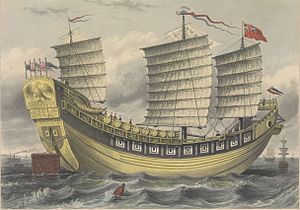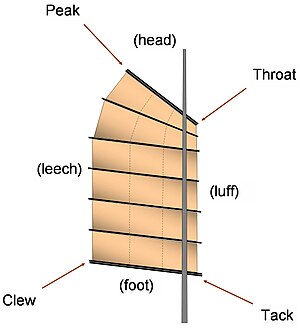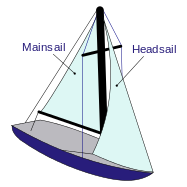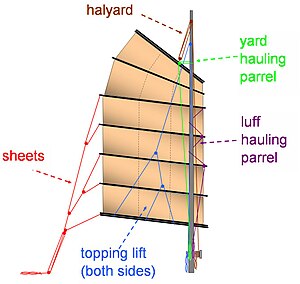Junk rig
This article may need to be rewritten to comply with Wikipedia's quality standards. (January 2017) |

The junk rig, also known as the Chinese lugsail or sampan rig, is a type of sail rig in which rigid members, called battens, span the full width of the sail and extend the sail forward of the mast.[1][2]
While relatively uncommon in use among modern production sailboats, the rig's advantages of easier use and lower maintenance for blue-water cruisers have been explored by individuals such as trans-Atlantic racer Herbert "Blondie" Hasler and author Annie Hill.
History[]
The origin of the junk sailing rig is not directly recorded. The Chinese adopted the sail design from other cultures, although the Chinese made their own improvements over time. Paul Johnstone and George Hourani attribute the invention of this type of sail to Austronesian peoples from Indonesia. They were originally made from woven mats reinforced with bamboo, dating back to at least several hundred years BCE. They were adopted by the Chinese after contact with Southeast Asian traders (K'un-lun po) by the time of the Han dynasty (206 BCE to 220 CE).[3]: 12–13 [4]: 191–192 However, Chinese vessels during this era were essentially fluvial (riverine); China did not build true ocean-going fleets until the 10th century Song dynasty.[5][6] A UNESCO study argues that the Chinese were using square sails during the Han dynasty; only in the 12th century did the Chinese adopt the Austronesian junk sail. The term "junk rig" or sometimes simply "junk" is the name recorded by Europeans when they first encountered the ships in use by the Chinese. [7] The Chinese Navy was unrivaled around the 1400s with their distinctive and advanced ships utilizing the junk sail rig. Chinese ships of that time reached well over 400 feet long and 150 feet wide, some boasting more than eight masts. The junk ships were reported as having the ability to sail closer to the wind than any European boat as well as being extremely luxurious. Their mastery over the seas came to a sudden halt when the Chinese government mysteriously ordered the majority of their fleet to be destroyed in the 1500s. [8] Subsequently, the Chinese government made all trade with foreign countries a criminal action, as well as selling any remaining junk ships to foreigners. The Keying, which was bought by an Englishman and smuggled to New York in 1847 defying Chinese law, was an example of a Chinese junk sail rigged ship. Newspapers reported the Keying as having woven mat and bamboo sails which gave the boat "smooth and rapid movement". The Keying became an icon in England and was visited by the Queen before being entirely dismantled by the English in 1853 [9] History has little to say about the incredible technology and woodworking techniques used by the Chinese shipbuilders and sailmakers, with little more than small excerpts and mentions of astonishment remaining to verify even the very existence of these seemingly forgotten ocean behemoths. The Chinese ships utilized multiple huge unstayed masts, in configurations impossible to create with conventional standing rigging methods, made capable only by the exotic craftsmanship of the ships that employed them. All such skill and knowledge was perhaps destroyed along with the boats in the 1500s. No modern replicas of these giant sailing boats have been created. The Chinese junk ships of antiquity may remain the largest sailing ships in history.[8]
Often the word "junk" is used to describe both the unmistakable sail plan and the ships that were made famous by the Chinese, modernly referred to as a junk ship.[7] A hull referred to as a "junk ship" may carry a sailing rig that does not utilize a "junk sail", although it is extremely rare. A "junk sail", which has become the name for an ancient sail plan of unknown origins and being an independent creation from the Chinese "junk ship", may be rigged on any hull capable of carrying an unstayed mast or very minimal standing rigging. [5]
Junk sail rigged boats[]

As the origins of the junk sail remain unknown, no particular rig can claim to be the original or correct way to rig a junk sail. Some sailors have demonstrated the junk sails ability to work even in the presence of some standing rigging, such as the Colvin rig, although more care must be taken to prevent damage while sailing.[11]
Some ships that have been known to use junk sails include:
- Casco - a flat-bottomed barge originally used by the Tagalog people along the Pasig River and the Manila Bay
- Tongkang or "Tong'kang".[12] A light boat used commonly in the early 19th century to carry goods along rivers.
- , a type of vessel with one mast and junk rig. They were a common sight in the Singapore river in the mid-19th century.[13]
- Djong, The hull is pointed at fore and aft and some are equipped with bowsprit and bowsprit sail.
- Bedar, a type of ship from Malaya.
- Pinas, a Malay ship. [14]
- Lorcha, a light Chinese sailing vessel. This ship combined a western-style hull of Portuguese influence, with Chinese-style mast and sail.[15] The lorcha were found in the Gulf of Siam and in Philippine waters as well. The Vũng Tàu shipwreck consists of the remains of a late 17th-century lorcha from the South China Sea off the islands of Con Dao, about 160 km from Vũng Tàu, Vietnam.
There is no one specific junk sail plan and many variating designs exist. Square headed junk sails have parallel yards and booms and resemble rectangles. Fan-headed junk sails have yards angled forward at varying degrees. Split panel junk sails separate the sail plan in two sections, a main section behind the mast, and a smaller section forward the mast. This is done in an effort to mimic the effect of the "slot" created by separating the headsail and mainsail in Bermuda rigs, although the benefits of the "slot effect" are disputed.[16] Hybrids between a Bermuda sail and junk sail exist as well, attempting to join the junk sail rigs ease of use with tried and true Bermuda triangular sail plans, some examples being the Aerorig and Aerojunk.
General sail construction[]
This section needs additional citations for verification. (November 2016) |
Sail terminology[]

The junk sail has essentially the same sides and corner names as the traditional gaff rigged 4-corner sail.[1]
Knowing the names of the sides and corners help understand the running rigging and sail trim of the junk sail.
The 4 corners of the junk sail are:
- the peak or the top corner;
- the throat down the yard from the peak, close to the mast.
- the tack at the base of the mast and boom, which is "tacked" on to the boat and does not move.
- the clew at the end of the boom, connected to the sheet.
The 4 sides of the junk sail are:
- the head or top edge of the sail.
- the luff or front of the sail, the first part of the sail to "luff" or shake when sailing too close to the wind.
- the foot at the bottom, connected to the boom.
- the leach or trailing edge of the sail, where wind telltales might be found.
Sail components[]

A junk sail requires the following parts:
- The sailcloth material can be as simple as woven plant material, light canvas, tarpaulin, ripstop nylon, Dacron, or anything wind cannot permeate.[1][8][17] Camber, or shape, can be added in to junk sail panels in order to increase the possible performance on all points of sail, though doing so reduces the rigs simplicity and increases stress loads. It is unknown if ancient junk sails were constructed using cambered panels, flat panels, or if the panel material itself developed its own shape.
- The yard supports the head of the sail from the throat and peak. The yard is usually stronger relative to the battens because it supports the full weight of the sail. It also elevates the peak of the sail on fan headed junk sails.
- The battens support the sail from luff to leech. Batten materials that easily allow some bending while maintaining strength work best, such as bamboo and fiberglass,
- The boom is the spar at the foot of the junk sail. It supports the sail directly at the tack and the clew, and holds the sail assembly down at the tack using the tack line.
- The batten parrels are lengths of line or strap that hold the sail to the mast. They can be quite long in rigs which allowing the fore and aft movement of the sail across the mast. Such controls allow the sail to be centered on the mast for more stable downwind sailing.
- the tack parrel holds the boom to the mast.
- The tack line holds the boom down towards the deck and if adjustable is considered running rigging.
Sail controls[]
The running rigging controls the junk sail.
- The halyard raises the sail up the mast. It is usually connected to the middle of the yard.
- The yard hauling parrel holds the yard close to the mast. It runs from the yard around the mast, and down to the deck. The yard hauling parrel helps control the fore and aft movement of the sail in conjunction with the tack parrel, tack line and luff hauling parrel, but is not used on all junk sail rigs.
- The luff hauling parrel, is rigged from the luff of the sail at the battens to the mast in shoestring fashion such that when it is hauled, it will pull the middle battens aft but this is not a necessary part of the rig.
- The topping lift, also called "lazy jacks", holds the boom and sail up off the deck when the sail is not raised. The topping lift also serves to tame the junk sail acting as a cradle while hoisting and lowering and is also not an essential part of the junk sail rig.
- The sheets control of the trim of the sail. In some junk sails the sheets are connected to both the boom and multiple battens. Doing so enables a flat cut junk sail to improve windward capabilities by tensioning some battens more than others which encourages bending that creates shape in a flat cut sail. In such a setup the multiple sheets connected to battens often join together in some way, called a euphroe which is a long piece of wood with holes in it, that enables a single line to trim the sail like modern Bermuda rigs. Ship designers , and Herbert "Blondie" Hasler employed such a technique, but others such as and Phil Bolger simplified the design without euphroes.[18][19] Cambered junk rigs are generally sheeted directly to the boom, as extra shape is not necessary.
An interesting side note is that a small Bermuda rig sail can be constructed from a single cut, out of a single cloth, and still sail effectively. A junk sail, by definition, requires multiple individually cut panels sewn together.
Comparison with Bermuda rig[]
This section does not cite any sources. (July 2015) |
Rig comparison[]


A junk sail rig contrasts starkly with a fully stayed Bermuda sloop rig which has become the standard rig for modern sailboats. Junk sails are carried on an unstayed mast, though minimal rigging can be employed, sometimes only temporarily. Occasionally one or more mast is leaning forward toward the bow which is called mast raking. The forward rake encourages the junk sail to swing out, which makes the use of a preventer unnecessary. A Bermuda rig sails better with the mast raked backwards, or to stern, but raking a mast to stern causes issues sailing in light winds as the boom attempts to center itself when the wind drops and causes a stall[20] Independent from mast rake, a slight bending of the mast to match the luff of the sail is also crucial to maximize the performance of a fully stayed Bermuda rig. Both mast rake and bend requires the standing rigging to be precisely tuned.[21] Mast bending can be beneficial with junk sails as well and an unstayed mast will easily bend as it is free from standing rigging.
A Bermuda sail rig incurs more hull and rig stresses, compared to a junk sail rig, and resembles a triangle which is the most inefficient shape for sailing.[22] Junk sail rigs displace stress loads more evenly and efficiently across the sail, mast and hull which results in lower strains overall. Junk sails utilizing cambered panels may be less durable depending on construction methods. The flat cut junk sail makes use of a natural driving force created by a purpose made sail design, as opposed to the high efficiency curves built into Bermuda sails that depend upon modern composite materials to hold their shape. Until around the mid-1950s, when modern composite sailcloth became widely used, the sails for Bermuda rigs were constructed using Egyptian cotton and had much shorter lifespans because the camber cut in to the cotton sails would lose its shape quickly.[23] Interestingly, more modern Bermuda rigs use two independent backstays to make room for a "square head" main sail which has four sides, as opposed to a "pin head" sail which has three sides, as such a sail plan performs better. Many modern "square head" Bermuda rig main sails closely resemble the outline of some junk sails.[24]
Performance comparison[]

When sailing upwind, a flat cut junk sail is usually slower than a similarly sized Bermuda sail, especially in light winds. This is due to the inability of the battens to bend and create shape and lends credence to the reputation of a junk sails poor abilities against the wind. However, in high winds the battens will bend to some degree which creates shape in the flat sail and an increase in both speed and ability to point in to the wind. Even in high winds a flat cut junk sail has not been shown to point as close to the wind as a Bermuda sail, although the flat cut junk sail is undoubtably easier to handle. Cambered junk sails, in amazing contrast, have shown the potential to out perform an equally sized Bermuda sail, even in light airs, by producing near comparable speeds and an ability to point closer to the wind.[17] Junk sails are also self tacking meaning trimming a sail after a tack is not necessary.
When reaching in light winds a flat cut junk sail is usually slower than a similarly sized Bermuda rig but a cambered junk sail can produce more comparable speeds.[17] In moderate and high winds a flat or cambered junk sail is just as capable as a Bermuda sail rig. Most junk sail rigs also have more trimming options on a reach due to the lack of standing rigging, and while that is not necessarily a performance benefit, it can create a more comfortable experience. A Bermuda sail will contact the standing rigging if the sail is let out too far, usually only on a broad reach but sometimes while reaching,
When running and on a broad reach, junk sails are faster than a similarly sized Bermuda sail without a spinnaker.[17] Bermuda sails collapse often downwind, which is called a stall, due to the sails lack of rigid battens supporting it.[17][25] Without a spinnaker, downwind sailing in a Bermuda rig can be problematic and may require skilled handling to maintain adequate speeds, especially in light winds.[26] The full battens of a junk sail prevent the sail from collapsing and simultaneously dispense the need for a whisker pole which holds the clew of a Bermuda head sail out. Junk sails are also self-jibing, where a Bermuda sloop rig must focus on trimming a headsail. On double-masted or more junk sail boats, the sails can be flown on opposite sides of the boat, just like a Bermuda rig. Some junk sail rigs can move their sail forward, to center the sail on the mast, which stabilizes the boat when sailing with the wind and resembles a European square rig.
Handling comparison[]
Maneuverability in a junk rig is vastly beyond that of a fully stayed Bermuda sail rig, The junk sail can be raised or lowered irrelevant from wind direction. Likewise the sheet can be released to cause a stall at any point of sail to slow or stop, should conditions require. The junk sail will swing out with the wind around the unstayed mast. Releasing the sheet while reaching or running on a Bermuda rigged boat would cause the sail and boom to hit the shrouds, which are part of the standing rigging. A Bermuda sail must also be raised and lowered while headed in to the wind. Slowing or stopping while reaching or running would require a Bermuda rigged boat to turn and head into the wind. There is also less danger from an accidental jibe with a junk sail due to a lighter-weight boom, which is sometimes simply the lowest batten, and from the balance of the sail itself. A Bermuda cruising boat would tie the boom to a rail for long distance downwind sailing because accidental jibes with a heavy boom can cause serious injury. Junk sail rigs may do the same for increased safety.
Reefing a junk rigged sail is very easy, all that is needed is to ease the halyard. The sail is lowered into the topping lift, or lazy jacks, until the desired batten is along the boom. Junk sail rigs that utilize multiple sheets attached to various battens can continue sailing at that point without further adjustment. Junk sails that are sheeted only to the boom tend to need adjustment in some fashion to discourage the dropped sail from lifting off the boom by using a control line such as a downhaul, or even simply tying the batten down.
Raising a junk sail can be more complicated than a Bermuda sail. It can be important to watch the lines that may be working while the sail is raised, including the yard hauling parrel, luff hauling parrel, downhauls, and sheet or sheets. Junk sails utilizing wooden battens or similar heavy materials may need a block and tackle setup, however, some Chinese junk sails were extremely lightweight being made of bamboo and woven plants.[9] Many modern junk sails are constructed with light aluminum tubes [17]The halyard is hauled until the tack line is taut, and there is no need to tighten up the leech severely to avoid scallops as in trimming a Bermuda sail. Some junk sails require the fore and aft position of the leech to be set by tensioning the yard hauling parrel and luff hauling parrel. Some junk sails may be pre-balanced and simplify the control lines down to a halyard, sheet, and lazy jacks. Such a simplification negates the ability to center the junk sail on the mast in order to stabilize downwind use which would require a luff hauling parrel, yard hauling parrel and an adjustable tack line to use as controls in combination with long batten and tack parrels to allow sufficient movement.
Heaving to with a junk sail is similar in concept to a Bermuda rig and has more to do with the hull design than the sail rig. It can be as simple as heading the boat into the wind with the sails close hauled and putting the helm down when the forward speed is spent, which is where hull design plays a large part. Heaving to in severe weather on a multiple masted junk sail rig is done by dropping the forward sail or sails into their cradle and reefing the aft-most sail—which helps keeps the bow pointed into the wind, similar to a mizzen sail on a yawl or ketch.[27]
When short handed a junk sail has a clear advantage for many reasons, especially because of the rigs simplicity and dependability. It is typical to run the control lines to the companionway on a junk sail rigged boat. This means that typical sail handling can be performed from the relative safety of the cockpit, or even while the crew is . Blondie Hasler finished second in the 1960 OSTAR from England to the USA in a junk rigged self steering boat named Jester and claimed to have only handled the tiller for one hour.[28] Hasler invented the self steering system most sailing yachts derive their designs from to this day.[29] Other sailors such as Annie Hill testify to the junk sail rigs great ease and success. From a cruising perspective, almost any junk rigged boat is fast, easy to use, and inexpensive to set up and maintain.[30]
Major disadvantages[]
There are no production junk sail, rig, or boat manufacturers on the market. Almost every junk sail rig is experimental to some degree resulting in myths and marred reputations. The sails must be constructed by hand or found. Standardized parts, general repair advice, sailing classes etc. are virtually non-existent. Most modern production sail boats are deck stepped mast rigs, meaning the mast ends on the deck of the boat. Under the mast is a much smaller, lighter, compression pole resting on the keel of the boat essentially creating a two part mast. The mast is held upright by the standing rigging making an unstayed mast impossible. A deck stepped Bermuda rigged boat would require hull modifications and possibly a new one part mast in order to carry a junk sail.
Notable sailors[]
Annie Hill sailed a junk-rigged dory and wrote of its virtues in her book Voyaging on a Small Income. Her ship Badger was designed by Jay Benford.[31]
Bill King sailed the junk schooner (i.e. junk-rigged boat with two masts) Galway Blazer II in the Sunday Times Golden Globe Race.
Joshua Slocum and his family built and sailed a junk-rigged boat Liberdade from Brazil to Washington, DC after the wreck of his barque Aquidneck. Slocum had high praise for the practicality of the junk rig: "Her rig was the Chinese sampan style, which is, I consider, the most convenient boat rig in the whole world."[32]
Herbert "Blondie" Hasler sailed a junk-rigged modified Nordic Folkboat to second place in the first trans-Atlantic race and was the author of Practical Junk Rig (ISBN 1-888671-38-6).
Kenichi Horie sailed across the Pacific Ocean in 1999 aboard a 32.8-foot (10.0 m) long, 17.4-foot (5.3 m) wide, catamaran constructed from 528 beer kegs. The rigging consisted of two side-by-side masts with junk rig sails made from recycled plastic bottles.
Roger Taylor has completed a number of high-latitude voyages in small junk-rigged yachts named Mingming and Mingming II.[33]
See also[]
- Lug sail
- Tanja sail, or balanced lug, a type of sail also invented by Malay people
- Lateen sail
References[]
- ^ a b c Hasler & MacLeod, Practical Junk Rig, Tiller Publishing. [VM531.H37]
- ^ van Loan, Derek; Haggerty, Dan (2006), The Chinese Sailing Rig, Paradise Cay Publications, ISBN 9780939837700.
- ^ Shaffer, Lynda Norene (1996). Maritime Southeast Asia to 1500. M.E. Sharpe.
- ^ Johnstone, Paul (1980). The Seacraft of Prehistory. Cambridge: Harvard University Press. ISBN 978-0674795952.
- ^ a b L. Pham, Charlotte Minh-Hà (2012). Asian Shipbuilding Technology. Bangkok: UNESCO Bangkok Asia and Pacific Regional Bureau for Education. pp. 20–21. ISBN 978-92-9223-413-3.
- ^ Maguin, Pierre-Yves (September 1980). "The Southeast Asian Ship: An Historical Approach". Journal of Southeast Asian Studies. 11 (2): 266–276. doi:10.1017/S002246340000446X. JSTOR 20070359.
- ^ a b Why Junk?, Friend.ly Net, archived from the original on 2006-08-13.
- ^ a b c "Ancient Chinese Explorers". www.pbs.org. Retrieved 2021-07-12.
- ^ a b isleofdogslife (2018-02-14). "The Strange Story of the Chinese Junk Keying at Blackwall in 1848". Isle of Dogs Life. Retrieved 2021-07-12.
- ^ http://www.thomasecolvin.com/ Thomas Colvin naval architect
- ^ Doane, Charles (2010-12-13). "COLVIN GAZELLE: A Junk-Rigged Cruising Icon". Wave Train. Retrieved 2021-07-11.
- ^ "Tongkang" – via The Free Dictionary.
- ^ "Association Of Singapore Marine Industries - Anchored in Singapore History : Made in Singapore".
- ^ Gibson-Hill, C. A. (August 1952). "Tongkang and Lighter Matters". Journal of the Malayan Branch of the Royal Asiatic Society. 25: 84–110 – via JSTOR.
- ^ Shunshin Chin & Joshua A. Fogel, The Taiping Rebellion
- ^ "Advances in sail aerodynamics - part two".
- ^ a b c d e f Owner, Practical Boat (2014-11-25). "Bermudan rig vs Junk rig". Practical Boat Owner. Retrieved 2021-06-13.
- ^ "Junk Sails: A Tutorial".
- ^ Kasten, Michael. "Consider The Junk Rig".
- ^ Gerr, Dave. "What Mast Rake is All About". Sail Magazine. Retrieved 2021-07-09.
- ^ "Bend for Speed". Sailing World. Retrieved 2021-07-09.
- ^ Hancock, Brian. "Know How: All About Mainsails". Sail Magazine. Retrieved 2021-06-13.
- ^ Downey, Peggy. "Whatever Happened to the Little Old Sailmaker?". Sports Illustrated Vault | SI.com. Retrieved 2021-06-13.
- ^ Amy (2014-11-23). "Square Top Mainsail Rigging". Out Chasing Stars. Retrieved 2021-06-13.
- ^ "Is The Sailing Sloop the Simplest of All Cruising Sailboat Rigs?". Sailboat Cruising. Retrieved 2021-07-19.
- ^ July 26, Posted; 2018 (2018-07-26). "Cruisers Sailing Faster - Sail Trim and Technique". SpinSheet. Retrieved 2021-07-19.CS1 maint: numeric names: authors list (link)
- ^ "What's in a Rig? The Yawl". American Sailing Association. 2015-09-09. Retrieved 2021-07-18.
- ^ "The Royal Western Yacht Club of England | OSTAR 1960". Retrieved 2021-07-10.
- ^ Monthly, Yachting (2018-10-15). "Windvane steering: why it makes sense for coastal cruising". Yachting Monthly. Retrieved 2021-07-10.
- ^ * Voyaging On a Small Income ISBN 1-85310-425-6
- ^ "Benford Design Group".
- ^ Slocum, Joshua, The Voyage of the Liberdade, Press of Robinson & Stephenson, 1890. Reprinted by Roberts Brothers, Boston, 1894 and thereafter. Also available online http://www.ibiblio.org/eldritch/js/liberdade.htm
- ^ Taylor, Roger. "The Simple Sailor". Retrieved 6 January 2016.
Further reading[]
- Rousmaniere, John (June 1998). The Illustrated Dictionary of Boating Terms: 2000 Essential Terms for Sailors and Powerboaters (Paperback). W. W. Norton & Company. p. 174. ISBN 0393339181. ISBN 978-0393339185
External links[]
- Junk Rig Association
- Brian Platt's "The Chinese Sail"
- A collection of information concerning Chinese lugsails
- The Voyage of the Dragon King has detailed descriptions of sailing a junk rig, including a diagram and photos of the sheetlets and euphroe.
- Naval architect Jonque de Plaisance Modern sailing junks plans
- Naval architect 's Coin collection and Silver Gull series designs
- Collection of information an links on today's junk rigged vessels: www.klicktipps.de/sailing-junk-rig.php
- Naval history of China
- Sailing rigs and rigging
- Ships of China
- Indonesian inventions





